LAND ROVER DISCOVERY 2002 Workshop Manual
Manufacturer: LAND ROVER, Model Year: 2002, Model line: DISCOVERY, Model: LAND ROVER DISCOVERY 2002Pages: 1672, PDF Size: 46.1 MB
Page 321 of 1672

ENGINE - V8
12-2-78 OVERHAUL
Page 322 of 1672
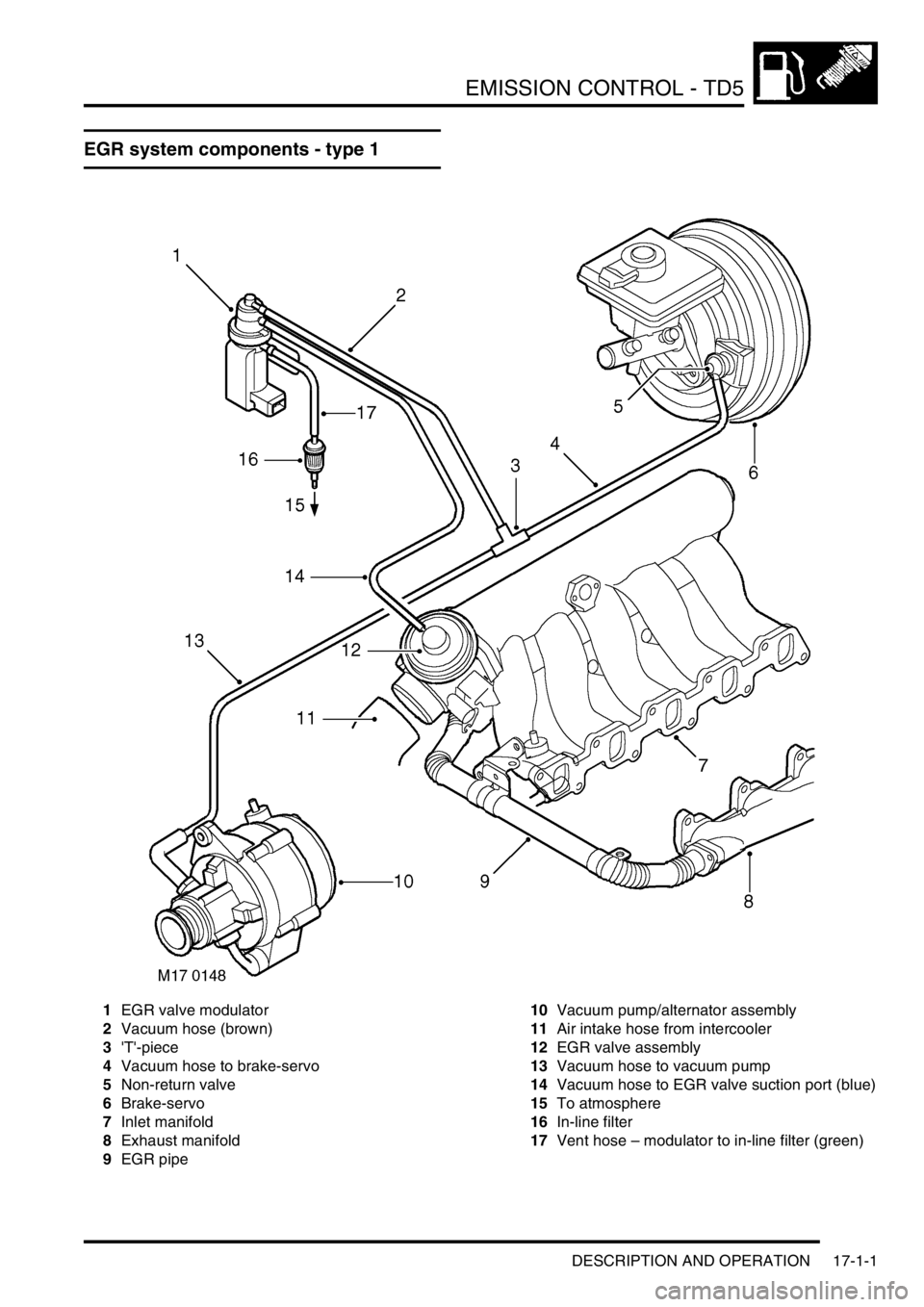
EMISSION CONTROL - TD5
DESCRIPTION AND OPERATION 17-1-1
EMISS ION CONTROL - Td5 DESCRIPTION AND OPERAT ION
EGR system components - type 1
1EGR valve modulator
2Vacuum hose (brown)
3'T'-piece
4Vacuum hose to brake-servo
5Non-return valve
6Brake-servo
7Inlet manifold
8Exhaust manifold
9EGR pipe10Vacuum pump/alternator assembly
11Air intake hose from intercooler
12EGR valve assembly
13Vacuum hose to vacuum pump
14Vacuum hose to EGR valve suction port (blue)
15To atmosphere
16In-line filter
17Vent hose – modulator to in-line filter (green)
Page 323 of 1672

EMISSION CONTROL - TD5
17-1-2 DESCRIPTION AND OPERATION
EGR system components - type 2
Inset A shows the Pre EU3 condition for the EGR pipe and inset B shows the Pre EU3 condition filter and venting.
Page 324 of 1672

EMISSION CONTROL - TD5
DESCRIPTION AND OPERATION 17-1-3
1ILT valve modulator
2ILT modulator vacuum hose (brown)
3EGR valve modulator
4EGR modulator vacuum hose (brown)
5Vent hose – EGR modulator to in-line filter
(green)
6Vacuum hose to ILT valve suction port (blue)
7Vacuum hose to EGR valve suction port (blue)
8'T'-piece (4–way)
9Vacuum hose to brake-servo
10Non-return valve
11Brake-servo
12Inlet manifold
13Exhaust manifold
14ILT valve
15EGR cooler - EU3 models
16Vacuum pump / alternator assembly
17Air intake hose from intercooler
18EGR valve (incorporating ILT valve) assembly
19Vacuum hose to vacuum pump
20Vent hose – ILT valve modulator to in-line filter
(green)
213–way connector
22Vent hose - to air cleaner
23ILT modulator harness connector (green)
24EGR modulator harness connector (black)
25To atmosphere - Pre EU3 models
26In-line filter - Pre EU3 models
27EGR pipe - Pre EU3 models
Page 325 of 1672
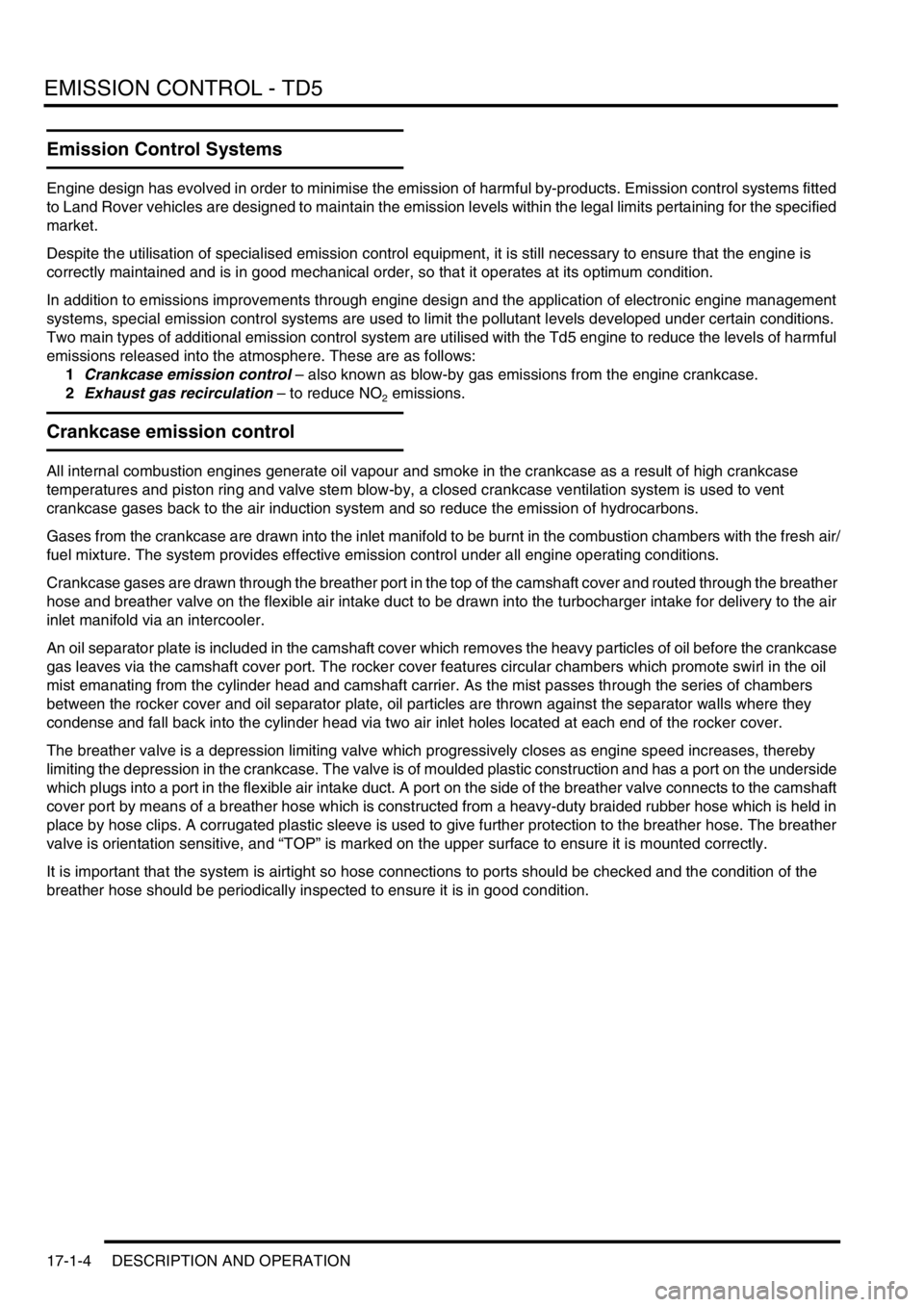
EMISSION CONTROL - TD5
17-1-4 DESCRIPTION AND OPERATION
Emission Control Systems
Engine design has evolved in order to minimise the emission of harmful by-products. Emission control systems fitted
to Land Rover vehicles are designed to maintain the emission levels within the legal limits pertaining for the specified
market.
Despite the utilisation of specialised emission control equipment, it is still necessary to ensure that the engine is
correctly maintained and is in good mechanical order, so that it operates at its optimum condition.
In addition to emissions improvements through engine design and the application of electronic engine management
systems, special emission control systems are used to limit the pollutant levels developed under certain conditions.
Two main types of additional emission control system are utilised with the Td5 engine to reduce the levels of harmful
emissions released into the atmosphere. These are as follows:
1Crankcase emission control – also known as blow-by gas emissions from the engine crankcase.
2Exhaust gas recirculation – to reduce NO
2 emissions.
Crankcase emission control
All internal combustion engines generate oil vapour and smoke in the crankcase as a result of high crankcase
temperatures and piston ring and valve stem blow-by, a closed crankcase ventilation system is used to vent
crankcase gases back to the air induction system and so reduce the emission of hydrocarbons.
Gases from the crankcase are drawn into the inlet manifold to be burnt in the combustion chambers with the fresh air/
fuel mixture. The system provides effective emission control under all engine operating conditions.
Crankcase gases are drawn through the breather port in the top of the camshaft cover and routed through the breather
hose and breather valve on the flexible air intake duct to be drawn into the turbocharger intake for delivery to the air
inlet manifold via an intercooler.
An oil separator plate is included in the camshaft cover which removes the heavy particles of oil before the crankcase
gas leaves via the camshaft cover port. The rocker cover features circular chambers which promote swirl in the oil
mist emanating from the cylinder head and camshaft carrier. As the mist passes through the series of chambers
between the rocker cover and oil separator plate, oil particles are thrown against the separator walls where they
condense and fall back into the cylinder head via two air inlet holes located at each end of the rocker cover.
The breather valve is a depression limiting valve which progressively closes as engine speed increases, thereby
limiting the depression in the crankcase. The valve is of moulded plastic construction and has a port on the underside
which plugs into a port in the flexible air intake duct. A port on the side of the breather valve connects to the camshaft
cover port by means of a breather hose which is constructed from a heavy-duty braided rubber hose which is held in
place by hose clips. A corrugated plastic sleeve is used to give further protection to the breather hose. The breather
valve is orientation sensitive, and “TOP” is marked on the upper surface to ensure it is mounted correctly.
It is important that the system is airtight so hose connections to ports should be checked and the condition of the
breather hose should be periodically inspected to ensure it is in good condition.
Page 326 of 1672
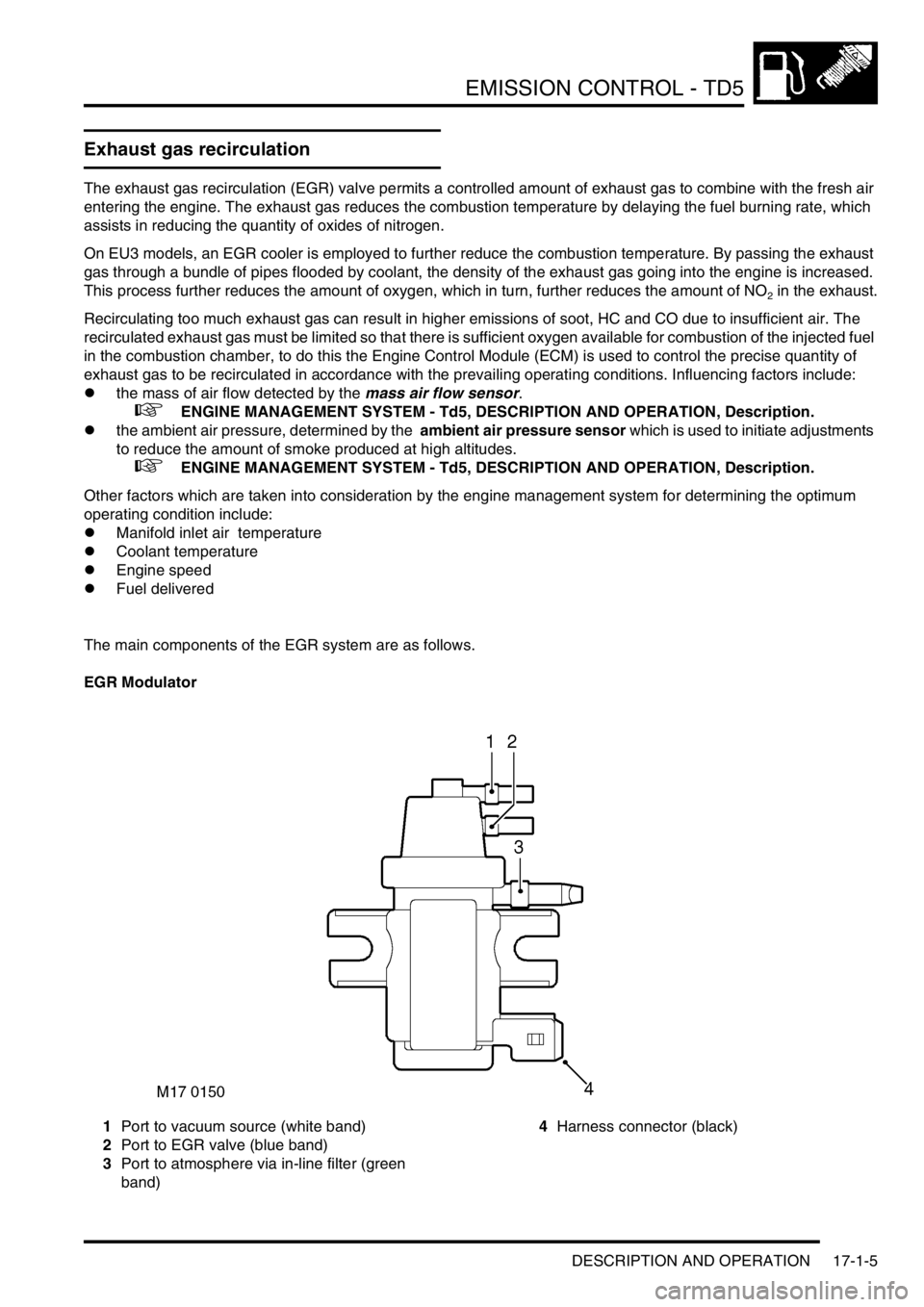
EMISSION CONTROL - TD5
DESCRIPTION AND OPERATION 17-1-5
Exhaust gas recirculation
The exhaust gas recirculation (EGR) valve permits a controlled amount of exhaust gas to combine with the fresh air
entering the engine. The exhaust gas reduces the combustion temperature by delaying the fuel burning rate, which
assists in reducing the quantity of oxides of nitrogen.
On EU3 models, an EGR cooler is employed to further reduce the combustion temperature. By passing the exhaust
gas through a bundle of pipes flooded by coolant, the density of the exhaust gas going into the engine is increased.
This process further reduces the amount of oxygen, which in turn, further reduces the amount of NO
2 in the exhaust.
Recirculating too much exhaust gas can result in higher emissions of soot, HC and CO due to insufficient air. The
recirculated exhaust gas must be limited so that there is sufficient oxygen available for combustion of the injected fuel
in the combustion chamber, to do this the Engine Control Module (ECM) is used to control the precise quantity of
exhaust gas to be recirculated in accordance with the prevailing operating conditions. Influencing factors include:
lthe mass of air flow detected by the mass air flow sensor.
+ ENGINE MANAGEMENT SYSTEM - Td5, DESCRIPTION AND OPERATION, Description.
lthe ambient air pressure, determined by the ambient air pressure sensor which is used to initiate adjustments
to reduce the amount of smoke produced at high altitudes.
+ ENGINE MANAGEMENT SYSTEM - Td5, DESCRIPTION AND OPERATION, Description.
Other factors which are taken into consideration by the engine management system for determining the optimum
operating condition include:
lManifold inlet air temperature
lCoolant temperature
lEngine speed
lFuel delivered
The main components of the EGR system are as follows.
EGR Modulator
1Port to vacuum source (white band)
2Port to EGR valve (blue band)
3Port to atmosphere via in-line filter (green
band)4Harness connector (black)
Page 327 of 1672
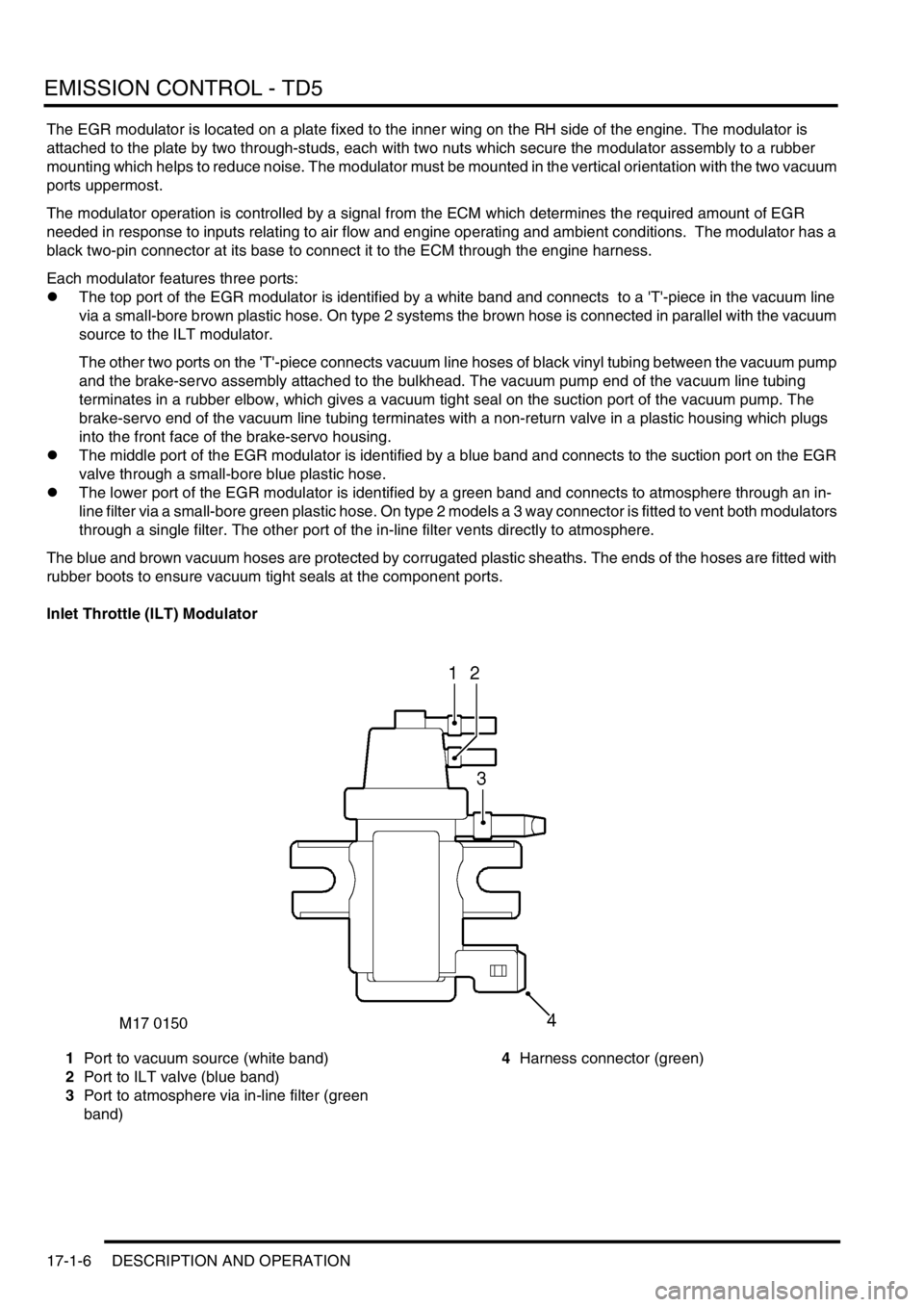
EMISSION CONTROL - TD5
17-1-6 DESCRIPTION AND OPERATION
The EGR modulator is located on a plate fixed to the inner wing on the RH side of the engine. The modulator is
attached to the plate by two through-studs, each with two nuts which secure the modulator assembly to a rubber
mounting which helps to reduce noise. The modulator must be mounted in the vertical orientation with the two vacuum
ports uppermost.
The modulator operation is controlled by a signal from the ECM which determines the required amount of EGR
needed in response to inputs relating to air flow and engine operating and ambient conditions. The modulator has a
black two-pin connector at its base to connect it to the ECM through the engine harness.
Each modulator features three ports:
lThe top port of the EGR modulator is identified by a white band and connects to a 'T'-piece in the vacuum line
via a small-bore brown plastic hose. On type 2 systems the brown hose is connected in parallel with the vacuum
source to the ILT modulator.
The other two ports on the 'T'-piece connects vacuum line hoses of black vinyl tubing between the vacuum pump
and the brake-servo assembly attached to the bulkhead. The vacuum pump end of the vacuum line tubing
terminates in a rubber elbow, which gives a vacuum tight seal on the suction port of the vacuum pump. The
brake-servo end of the vacuum line tubing terminates with a non-return valve in a plastic housing which plugs
into the front face of the brake-servo housing.
lThe middle port of the EGR modulator is identified by a blue band and connects to the suction port on the EGR
valve through a small-bore blue plastic hose.
lThe lower port of the EGR modulator is identified by a green band and connects to atmosphere through an in-
line filter via a small-bore green plastic hose. On type 2 models a 3 way connector is fitted to vent both modulators
through a single filter. The other port of the in-line filter vents directly to atmosphere.
The blue and brown vacuum hoses are protected by corrugated plastic sheaths. The ends of the hoses are fitted with
rubber boots to ensure vacuum tight seals at the component ports.
Inlet Throttle (ILT) Modulator
1Port to vacuum source (white band)
2Port to ILT valve (blue band)
3Port to atmosphere via in-line filter (green
band)4Harness connector (green)
Page 328 of 1672
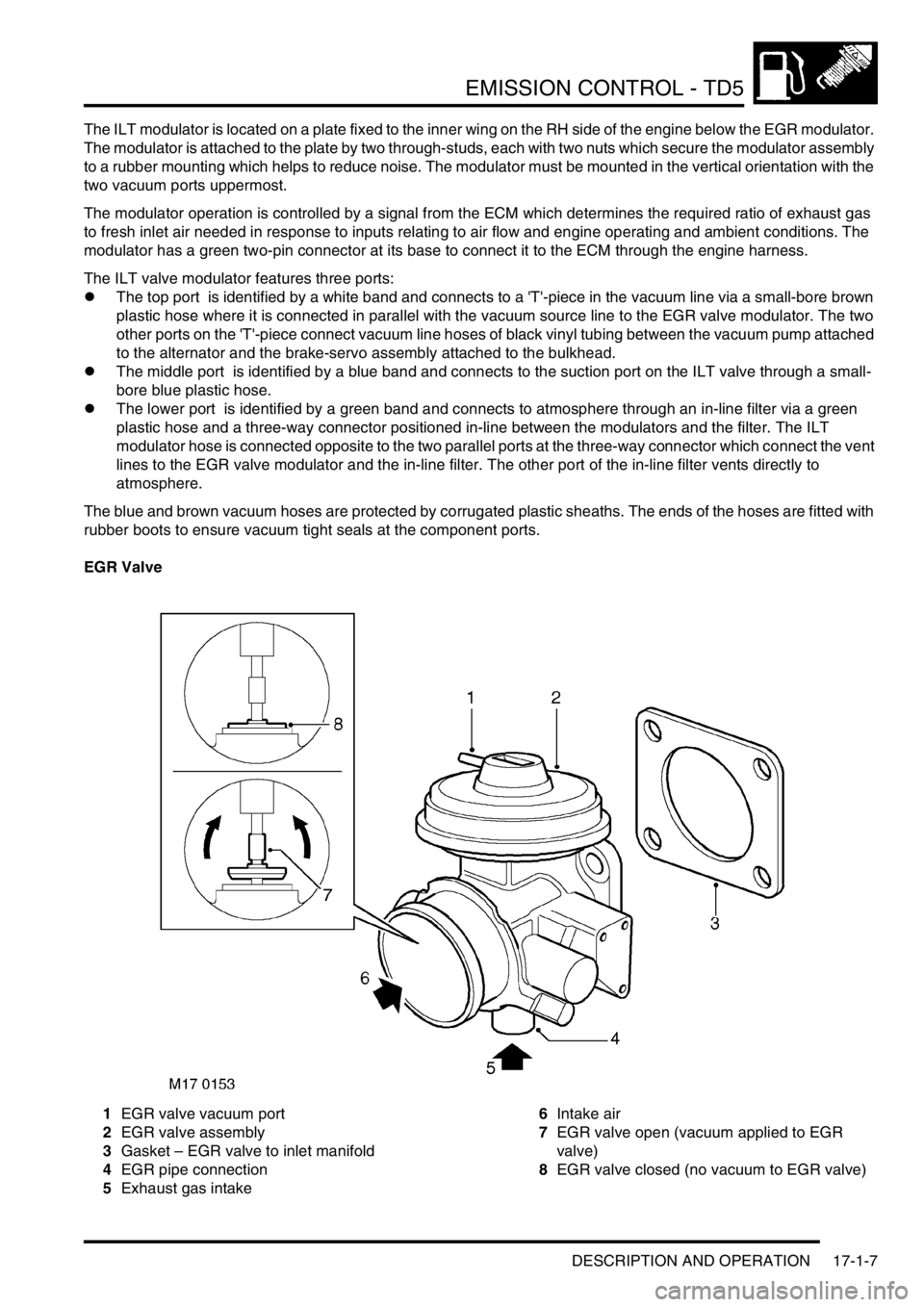
EMISSION CONTROL - TD5
DESCRIPTION AND OPERATION 17-1-7
The ILT modulator is located on a plate fixed to the inner wing on the RH side of the engine below the EGR modulator.
The modulator is attached to the plate by two through-studs, each with two nuts which secure the modulator assembly
to a rubber mounting which helps to reduce noise. The modulator must be mounted in the vertical orientation with the
two vacuum ports uppermost.
The modulator operation is controlled by a signal from the ECM which determines the required ratio of exhaust gas
to fresh inlet air needed in response to inputs relating to air flow and engine operating and ambient conditions. The
modulator has a green two-pin connector at its base to connect it to the ECM through the engine harness.
The ILT valve modulator features three ports:
lThe top port is identified by a white band and connects to a 'T'-piece in the vacuum line via a small-bore brown
plastic hose where it is connected in parallel with the vacuum source line to the EGR valve modulator. The two
other ports on the 'T'-piece connect vacuum line hoses of black vinyl tubing between the vacuum pump attached
to the alternator and the brake-servo assembly attached to the bulkhead.
lThe middle port is identified by a blue band and connects to the suction port on the ILT valve through a small-
bore blue plastic hose.
lThe lower port is identified by a green band and connects to atmosphere through an in-line filter via a green
plastic hose and a three-way connector positioned in-line between the modulators and the filter. The ILT
modulator hose is connected opposite to the two parallel ports at the three-way connector which connect the vent
lines to the EGR valve modulator and the in-line filter. The other port of the in-line filter vents directly to
atmosphere.
The blue and brown vacuum hoses are protected by corrugated plastic sheaths. The ends of the hoses are fitted with
rubber boots to ensure vacuum tight seals at the component ports.
EGR Valve
1EGR valve vacuum port
2EGR valve assembly
3Gasket – EGR valve to inlet manifold
4EGR pipe connection
5Exhaust gas intake6Intake air
7EGR valve open (vacuum applied to EGR
valve)
8EGR valve closed (no vacuum to EGR valve)
Page 329 of 1672
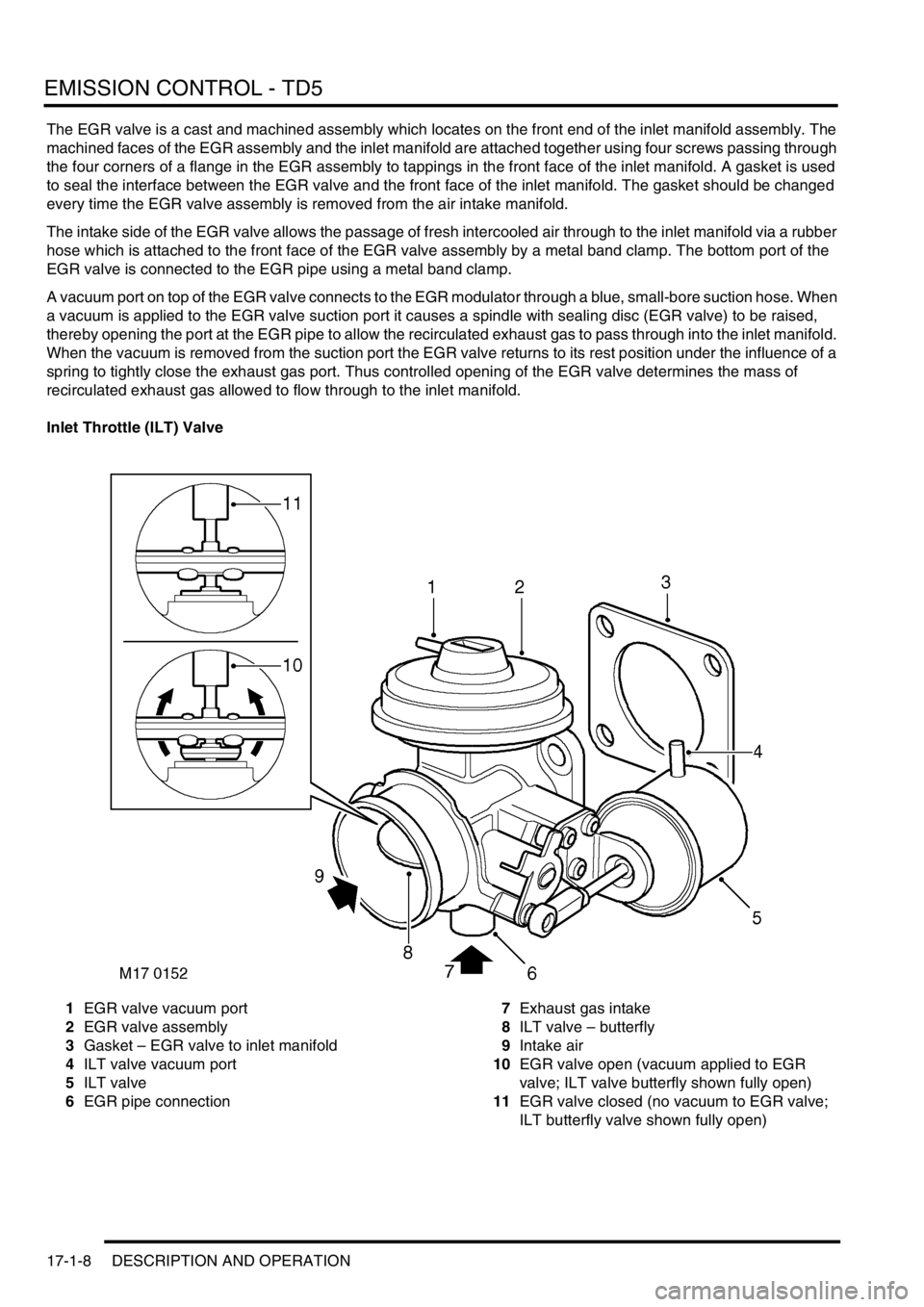
EMISSION CONTROL - TD5
17-1-8 DESCRIPTION AND OPERATION
The EGR valve is a cast and machined assembly which locates on the front end of the inlet manifold assembly. The
machined faces of the EGR assembly and the inlet manifold are attached together using four screws passing through
the four corners of a flange in the EGR assembly to tappings in the front face of the inlet manifold. A gasket is used
to seal the interface between the EGR valve and the front face of the inlet manifold. The gasket should be changed
every time the EGR valve assembly is removed from the air intake manifold.
The intake side of the EGR valve allows the passage of fresh intercooled air through to the inlet manifold via a rubber
hose which is attached to the front face of the EGR valve assembly by a metal band clamp. The bottom port of the
EGR valve is connected to the EGR pipe using a metal band clamp.
A vacuum port on top of the EGR valve connects to the EGR modulator through a blue, small-bore suction hose. When
a vacuum is applied to the EGR valve suction port it causes a spindle with sealing disc (EGR valve) to be raised,
thereby opening the port at the EGR pipe to allow the recirculated exhaust gas to pass through into the inlet manifold.
When the vacuum is removed from the suction port the EGR valve returns to its rest position under the influence of a
spring to tightly close the exhaust gas port. Thus controlled opening of the EGR valve determines the mass of
recirculated exhaust gas allowed to flow through to the inlet manifold.
Inlet Throttle (ILT) Valve
1EGR valve vacuum port
2EGR valve assembly
3Gasket – EGR valve to inlet manifold
4ILT valve vacuum port
5ILT valve
6EGR pipe connection7Exhaust gas intake
8ILT valve – butterfly
9Intake air
10EGR valve open (vacuum applied to EGR
valve; ILT valve butterfly shown fully open)
11EGR valve closed (no vacuum to EGR valve;
ILT butterfly valve shown fully open)
Page 330 of 1672

EMISSION CONTROL - TD5
DESCRIPTION AND OPERATION 17-1-9
The ILT valve is used on certain exhaust gas recirculation systems in addition to the standard EGR valve described
above. The ILT valve assembly is mounted at right angles to the EGR valve on the left hand side of the EGR valve
assembly. It is fixed to the EGR valve assembly by three screws.
A vacuum port on top of the ILT valve connects to the ILT modulator though a blue, small-bore suction hose. When
a vacuum is applied to the inlet throttle (ILT) valve suction port, a butterfly valve in the inlet manifold closes via a
spindle and lever mechanism, limiting the supply of fresh intercooled air and creating a depression in the intake
manifold which in turn causes a greater suction at the open port to the EGR delivery pipe. When the vacuum source
is removed from the ILT valve suction port, a spring returns the butterfly to its fully open position. The ILT valve and
EGR valve are operated in conjunction to control the proportional masses of fresh intake air and recirculated exhaust
gas that is allowed to flow through to the inlet manifold.
The EGR valve and ILT valve should be replaced as a single assembly.
In-line air filter - Pre EU3 models
1To modulator vent port
2Filter element
3To atmosphere
The in-line air filter is placed in the ventilation line to the EGR modulator (and the ILT modulator where fitted). The
modulators need to be able to vent to atmosphere in order to release the vacuum supplied to the EGR and ILT valves.
The filter prevents contamination entering the modulators via the vent port which could cause failure; the filter should
be periodically changed in accordance with recommended service intervals. The filter is attached to the rear side of
the mounting plate used to hold the vacuum modulators at the inner wing on the RH side of the engine. The filter is
held in position by a clamping bracket which is attached to the mounting plate through a nut and bolt. The filter must
be mounted in the vertical position.
Note: EU3 models are not fitted with an in-line filter, the ventilation line connects directly to the air cleaner housing,
where it vents to atmosphere.